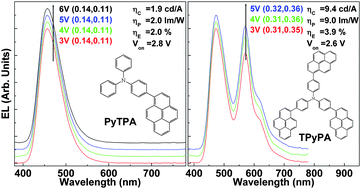Distinct electroluminescent properties of triphenylamine derivatives in blue organic light-emitting devices
Abstract
Two highly fluorescent triphenylamines (TPA) end-capped respectively with one and three

* Corresponding authors
a
Center of Super-Diamond and Advanced Films (COSDAF) and Department of Physics and Materials Science, City University of Hong Kong, Hong Kong SAR, China
E-mail:
qxtong@stu.edu.cn, apcslee@cityu.edu.hk
Fax: +86-754-82902767
b Department of Chemistry, Shantou University, Guangdong, China
c Department of Chemistry, The University of Hong Kong, Pokfulam Road, Hong Kong SAR, China
Two highly fluorescent triphenylamines (TPA) end-capped respectively with one and three

 Please wait while we load your content...
Something went wrong. Try again?
Please wait while we load your content...
Something went wrong. Try again?
S. Lai, Q. Tong, M. Chan, T. Ng, M. Lo, S. Lee and C. Lee, J. Mater. Chem., 2011, 21, 1206 DOI: 10.1039/C0JM02550J
To request permission to reproduce material from this article, please go to the Copyright Clearance Center request page.
If you are an author contributing to an RSC publication, you do not need to request permission provided correct acknowledgement is given.
If you are the author of this article, you do not need to request permission to reproduce figures and diagrams provided correct acknowledgement is given. If you want to reproduce the whole article in a third-party publication (excluding your thesis/dissertation for which permission is not required) please go to the Copyright Clearance Center request page.
Read more about how to correctly acknowledge RSC content.
 Fetching data from CrossRef.
Fetching data from CrossRef.
This may take some time to load.
Loading related content
